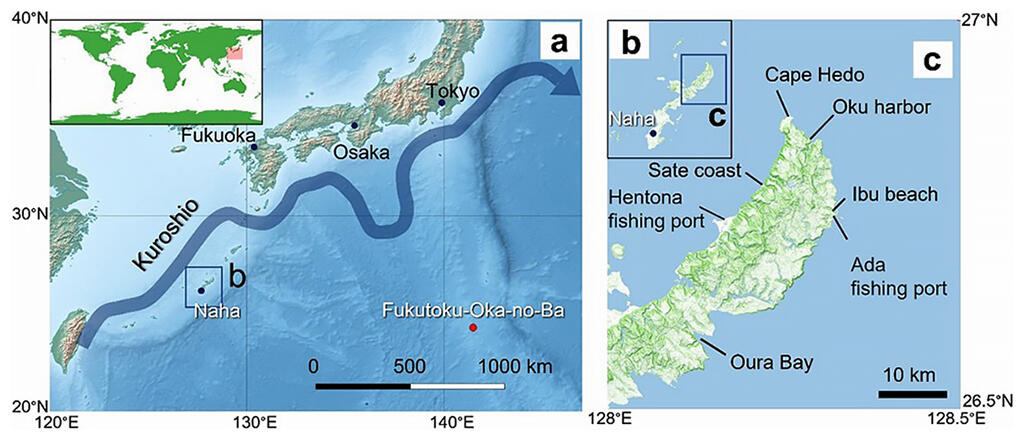A research group led by specially-appointed Assistant Professor Yoshikazu Ohno of the School of Marine Biosciences at Kitasato University, and Senior Researcher Akira Iguchi of the Research Laboratory for Environmentally-Conscious Developments and Technologies at the National Institute of Advanced Industrial Science and Technology, has investigated the effects on marine life in an area where a large amount of pumice from the eruption of the Fukutoku-Oka-no-Ba submarine volcano last August in the Ogasawara Islands has washed up. The group announced that they have found that organisms had begun to attach to the pumice in the vicinity where the pumice drifted. The research group made their discovery by surveying the coastal area of Yambaru National Park in northern Okinawa. Although pumice has been thought to contribute to biodiversity, it has also been found to have negative effects on some organisms. The group's results are expected to help shed light on the effects of pumice associated with undersea volcanic eruptions, and were published in the July 19 issue of Scientific Reports.

(a) Location of Fukutoku-Oka-no-Ba submarine volcano (red circle) and the Ryukyu Islands, Japan.
(b) Okinawa Island is ~ 1300 km from the eruption site.
(c) Sampling sites of drifted pumice along the coast of northern part of Okinawa Island (Kunigami Village) are shown in panel. The flow path of the Kuroshio Current shown in Panel a is based on Quick Bulletin of Ocean Conditions of Japan Coast Guard. Panel is made with Natural Earth (https://www.naturalearthdata.com). Topographic maps of panels b and c are based on GSI Vector Tile Experiment (https://maps.gsi.go.jp/vector/) by the Geospatial Information Authority of Japan.
Provided by Kitasato University
The eruption of the Fukutoku-Oka-no-Ba submarine volcano on August 13, 2021, caused a large amount of pumice to form masses (pumice rafts) that drifted across the ocean to the Nansei Islands over a distance of about 1,300 km, influenced by ocean currents and winds, in about two months. It was widely reported that the drifting pumice caused great damage to things such as boats and fisheries.
Many studies on pumice and biodiversity have been conducted abroad. These studies have shown that large numbers of organisms attach to the surface of pumice and travel great distances of thousands of kilometres, contributing to the dispersal of those organisms and biodiversity. On the other hand, the impact on marine life in areas where the drifts landed was not known.
The research group conducted a study of the effects of pumice rafts on marine life at their landing site after pumice rafts generated by the Fukutoku-Oka-no-Ba submarine volcano began drifting to Okinawa on October 13. Specifically, they surveyed the coastal area around Yambaru National Park, located in northern Okinawa, where the number of drifts was high, from October 16 to December 19. From this, they successfully observed marine life on the coast during the early stages of pumice drift.
At the beginning of the survey, there were no visible organisms attached to the pumice washed up on the beach, but after a few days into the survey, they found goose barnacles on a small portion of the pumice. Over a period of several weeks of observation, the barnacles were observed to have gradually grown larger. The goose barnacle is a member of an extremely fast-growing barnacle family, which spreads through larvae drifting in the sea and adhering to floating debris. This suggested that the apparent biofouling phenomenon began in the vicinity of Okinawa prefecture. The research group believes that since no large islands existed in the path of the pumice rafts from Fukutoku-Oka-no-Ba to the Nansei Islands, no organisms visible to the naked eye were able to attach to the rafts. Microscopic observations also confirmed the presence of microalgae on the surface of the pumice.
During the survey period, a large amount of pumice that had drifted onto the beach was observed to repeatedly leave and drift back onto the beach due to tides and the wind. The large amount of pumice caused the death of numerous farmed Indian mackerel at Hentona fishing harbour after they swallowed small pumice stones. Upon autopsy, it was confirmed that the intestines of the fish were filled with pumice. Since Indian mackerel are filter feeders, which means that they open their mouths wide to filter food through their gills, it is possible that the fish were unable to expel the pumice they swallowed. Fish with these characteristics may suffer similar damage in the sea.
The research group also succeeded in capturing images of numerous pumice stones colliding with underwater coral. Coral surfaces are covered with soft tissues, suggesting that physical contact may be stressful.
In addition, they also observed mangrove tidal flats to have changed from sandy mud to pumice, making it difficult for fiddler crabs to forage. They observed that the smaller crabs, in particular, did not appear to be able to dig burrows. They also observed competition for existing burrows.
The survey revealed that some organisms are negatively affected by pumice drifts. Because the pumice becomes smaller over time and eventually sinks, it is believed to have a transitory effect on coastal ecosystems.
"The mechanism by which invisible organisms attach to pumice has not yet been studied, and there remain many aspects of the role of pumice in marine ecosystems that are not understood," explains Dr. Ohno. "Moving forward, we would like to investigate how biofouling progresses on pumice immediately after an eruption. Pumice contains volcanic gases, and we think that immediately after an eruption the surface was highly reactive, making bioattachment difficult. We expect bacteria to form a biofilm, on which larger organisms (algae, ebony mussels) will adhere."
This article has been translated by JST with permission from The Science News Ltd.(https://sci-news.co.jp/). Unauthorized reproduction of the article and photographs is prohibited.




